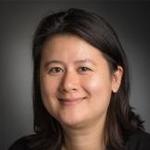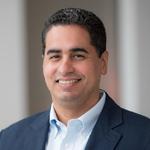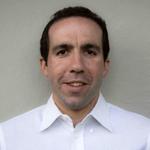
UCSF postdoc Oscar Campos, PhD, works in the Lim Lab on UCSF’s Mission Bay campus. Photo by Noah Berger, 2023.
Six investigators and teams were awarded grants in support of cancer research projects in the fall 2023 cycle of the UCSF Resource Allocation Program (RAP). Funded by various agencies across UCSF, the awards span a range of topics from telomere maintenance in pediatric brain tumors to the use of a novel imaging modality to assess metastatic kidney cancer.
RAP is a campus-wide program that bi-annually facilitates intramural research funding opportunities and seeds high-quality, high-impact, timely research. The program offers many benefits for investigators and campus agencies, including a single application, a streamlined review process, and access to funding that has a typical funding rate around 40 percent.
Read more about the recent awardees and their cancer research projects below.

Jennifer Rosenbluth, MD, PhD
Assistant Professor of Medicine, UCSF
Project: Breast Organoids as Models for Cancer Interception
Award Mechanism: Pilot for Early Career Investigators
Can you describe the focus of your project in a few sentences?
Breast lesions such as Ductal Carcinoma in Situ (DCIS) are significant risk factors for invasive breast cancer and are very heterogeneous. Some lesions will progress to aggressive invasive disease, but others would not progress even if they were not treated. Because we have no means to distinguish between these different types of DCIS, they are often treated with surgery, radiation, and for cases that express estrogen receptor (ER), with systemic anti-endocrine therapy. We are utilizing organoid culturing methodology to grow ER+ DCIS cells in the lab, so that we can better identify and understand why some cases are highly sensitive to anti-estrogen therapy and other cases are resistant to anti-estrogen therapy. For highly sensitive cases, our overall goal would be to de-escalate therapy for patients who do not require it, and for resistant cases our goal is to identify new therapies that could be used to treat the DCIS and prevent invasive breast cancer.
What motivated you to pursue this particular project?
Coming to UCSF and connecting with collaborators who are also interested in breast cancer prevention and these questions enabled the development of this project. This includes Drs. Laura Esserman, Ronald Balassanian, and Julia Ye, and we are also integrating with clinical trial efforts here, such as the recently initiated RECAST DCIS study. We are excited to be part of this group and to develop new model systems for ER+ DCIS.

Aaron Diaz, PhD
Associate Professor of Neurological Surgery, UCSF
Project: Targeting ZSCAN4 mediated telomere repair in pediatric brain tumors
Award Mechanism: Pilot for Established Investigators
Can you describe the focus of your project in a few sentences?
We seek to identify the mechanism of telomere maintenance in group 3 medulloblastoma. Medulloblastomas, the most common primary brain tumors in kids, have very short telomeres. Our preliminary data indicate that this disease may be particularly sensitive to therapeutic strategies that target telomere repair.
What motivated you to pursue this particular project?
All cancers need some mechanism of telomere repair to sustain indefinite replication. However, the mechanism of telomere elongation in group 3 medulloblastoma is unknown. Therapies targeting telomere repair are under active development in other cancers, but not yet in medulloblastoma.

Arpita Desai, MD
Assistant Professor of Medicine, UCSF
Project: Investigation of Hyperpolarized 13 C MRI to assess treatment response in metastatic kidney cancer
Award Mechanism: Pilot Award in Precision Imaging of Cancer and Therapy
Can you describe the focus of your project in a few sentences?
This application seeks to establish Hyperpolarized (HP) Carbon 13 (13C) pyruvate MRI imaging as a potential tool for metastatic kidney cancer assessment at UCSF. A pilot study enrolling 10 patients with metastatic kidney cancer will serve as a proof-of-concept, evaluating the modality's utility in this context. Subsequent data will inform the development of larger studies and grant applications focused on broader clinical applications of HP 13C pyruvate MRI in kidney cancer management.
What motivated you to pursue this particular project?
This pilot project explores the potential of Hyperpolarized (HP) Carbon 13 (13C) MRI as a novel imaging modality for assessing treatment response in metastatic kidney cancer. Current limitations in imaging sensitivity often impede accurate detection of localized and distant tumor spread, hindering optimal treatment decisions. HP 13C MRI is emerging as a promising tool for pathway-specific metabolic and physiologic investigation, offering crucial insights that were previously inaccessible. By implementing this non-invasive and rapid technique, the project aims to improve treatment monitoring and ultimately optimize patient care in this challenging clinical setting.

Manish Aghi, MD, PhD
Professor of Neurological Surgery, UCSF
Project: Skull Bone Marrow Contributes Antigen Presenting Hybrid Neutrophils to the Glioblastoma Microenvironment
Award Mechanism: Pilot for Established Investigators
Can you describe the focus of your project in a few sentences?
My RAP project follows up on data we have developed in my lab in which we found that a subset of neutrophils in patient glioblastomas are “hybrid neutrophils” that possess the ability to present antigens to and activate antitumoral T-cells. These cells appear to be more immature than circulating neutrophils from these same patients, resembling immature neutrophils from the bone marrow. Because immature neutrophils released from systemic bone marrow will mature when they enter the circulation, in this proposal we will investigate the hypothesis that these hybrid neutrophils arise from the skull bone marrow and get to the tumor via venous channels connecting the skull to the leptomeninges. We believe this process can be pharmacologically moderated via agents delivered therapeutically into the skull.
What motivated you to pursue this particular project?
I was motivated to pursue this project based on studies of the human brain outside of cancer in which a local immune system in the brain has been identified that houses myeloid antigen-presenting cells in the skull bone marrow where they are educated by CNS antigens and able to respond to events like trauma and infection in the CNS. I became curious if this process occurs in glioblastoma, an invariably lethal brain cancer.

Katherine Wai, MD
Assistant Professor of Otolaryngology, UCSF
Project: Defining the Immune Response to Checkpoint Inhibition in Head and Neck Cancer
Award Mechanism: Pilot for Early Career Investigators
Can you describe the focus of your project in a few sentences?
Immunotherapy has begun to change the landscape of treatment for head and neck cancer, resulting in some dramatic anti-tumor responses. However, only a small minority of patients show survival benefit, and it is unclear what predicts treatment response. The aim of this project is to employ single-cell spatial imaging technology to characterize changes in the systemic immune response among head and neck cancer patients treated with immunotherapy.
What motivated you to pursue this particular project?
As a head and neck cancer surgeon, I care for patients at every stage of their cancer care. Even among those who are cured, our current treatments require aggressive intervention, which often leave patients with significant morbidity, affecting their ability to speak or eat. With the support of my mentorship team (including Drs. Matt Spitzer, Patrick Ha, and Alain Algazi), I hope that this work will provide insight into the immunologic changes that underlie patients with head and neck cancer, answering fundamental questions that will inform a mechanistic approach to multimodal therapy.

Gregory Allen, MD, PhD
Assistant Professor of Medicine, UCSF
Project: Establishing new more rigorous pancreatic tumor models for pre-clinical evaluation of next-gen CAR T cell designs
Award Mechanism: Pilot Award for Pancreas Cancer
Can you describe the focus of your project in a few sentences?
Our ability to develop new immunotherapies for the clinic is greatly limited by the quality of our mouse models. Here we aim to build a new genetically engineered mouse model of pancreatic cancer. These models are intended to stress test CAR T cell designs to better identify which CAR T cell therapies are most likely to work in clinical trials and where these CAR T cell designs may fail in patients.
What motivated you to pursue this particular project?
Although we can generate and test a large number of new CAR T cell designs in mouse models, only a select few can be advanced to clinical trials. Understanding the strengths and weaknesses of these CAR T cell designs in mouse models will greatly improve the efficiency of our efforts in clinical translation.